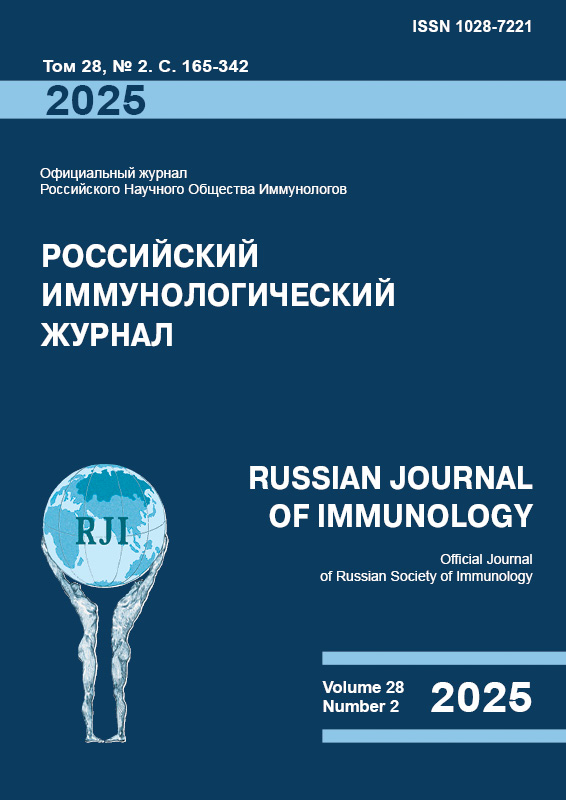Detection of allergen-specific Th2A-cells in peripheral blood of patients with allergic diseases
- 作者: Blinova E.A.1, Leonova M.I.1, Nepomnyaschikh V.M.1, Demina D.V.1
-
隶属关系:
- Research Institute of Fundamental and Clinical Immunology
- 期: 卷 28, 编号 2 (2025)
- 页面: 201-206
- 栏目: SHORT COMMUNICATIONS
- URL: https://journal-vniispk.ru/1028-7221/article/view/284822
- DOI: https://doi.org/10.46235/1028-7221-17054-DOA
- ID: 284822
如何引用文章
全文:
详细
There is an increase in the incidence of allergic diseases all over the world including Russia. The most common allergic disorders are allergic rhinitis, atopic dermatitis and bronchial asthma. Despite the differences in symptoms, the pathogenesis of all allergic diseases is based on activation of the Th2 immune response. A heterogeneous population of CD4+ lymphocytes is developed in response to allergen. Recently, a group of researchers described a population of terminally differentiated allergen-specific T cells that co-express CRTh2, CD161, and produced high levels of IL-5 and IL-9. This population was called pro-allergic “Th2A” cells. The aim of the present work was to assess the contents of allergen-specific Th2A cells and Th2 lymphocytes in allergic bronchial asthma, atopic dermatitis and allergic rhinitis. The study included 10 patients with allergic rhinitis, 9 cases of atopic dermatitis, 12 patients with allergic bronchial asthma and 8 healthy individuals. Phenotyping of Th2A cells (CD4+CD45RO+CD27-CRTh2+CD161+) and Th2 lymphocytes (CD4+CD45RO+CRTh2+) from mononuclear cells of peripheral blood was performed by flow cytometry. There were no significant differences in the number of Th2 lymphocytes, either between the donor’s group and all groups of patients with allergic diseases, or between groups of patients with different allergic diseases. A 3- to 4-fold increase in the number of Th2A cells compared to healthy individuals was observed in groups of patients with allergic rhinitis, atopic dermatitis, and a 2-fold increase was found in the group of patients with bronchial asthma. Moreover, the level of allergen-specific Th2A cells in patients with allergic rhinitis and in atopic dermatitis was significantly higher than in patients with bronchial asthma. This finding reflects probable involvement of Th2A cells in the pathogenesis of allergic diseases. Th2A cells may be also considered as a potential marker for tracing the course of allergic disease and assessing the efficiency of therapy, thus requiring further research in the field.
作者简介
E. Blinova
Research Institute of Fundamental and Clinical Immunology
编辑信件的主要联系方式.
Email: blinovaelena-85@yandex.ru
PhD (Biology), Senior Researcher, Laboratory of Clinical Immunopathology
俄罗斯联邦, NovosibirskM. Leonova
Research Institute of Fundamental and Clinical Immunology
Email: blinovaelena-85@yandex.ru
Allergologist, Clinic of Immunopathology
俄罗斯联邦, NovosibirskV. Nepomnyaschikh
Research Institute of Fundamental and Clinical Immunology
Email: blinovaelena-85@yandex.ru
Allergologist, Clinic of Immunopathology
俄罗斯联邦, NovosibirskD. Demina
Research Institute of Fundamental and Clinical Immunology
Email: blinovaelena-85@yandex.ru
PhD (Medicine), Head, Allergological Department, Clinic of Immunopathology
俄罗斯联邦, Novosibirsk参考
- Аллергология и иммунология: национальное руководство / Под ред. Р.М. Хаитова, Н.И. Ильиной. М.: ГЭОТАР-Медиа, 2009. 656 с. [Allergology and immunology: national guide / ed. By R.M. Khaitov, N.I. Ilyina]. M.: GEOTAR-Media, 2009. 656 p.
- Блинова Е.А., Галдина В.А., Сухова Н.М., Демина Д.В. Экспрессия PD-1 на популяциях Т-клеток периферической крови пациентов с аллергическими заболеваниями // Российский иммунологический журнал, 2023. Т. 26, № 1. С. 63-68. [Blinova E.A., Galdina V.A., Suchova N.M., Demina D.V. PD-1 expression on T cell subsets from peripheral blood of patients with allergic diseases. Rossiyskiy immunologicheskiy zhurnal = Russian Journal of Immunology, 2023, Vol. 26, no. 1, pp. 63-68. (In Russ.)] doi: 10.46235/1028-7221-1197-PEO.
- Курбачева О.М., Козулина И.Е. И вновь об аллергии: эпидемиология и основы патогенеза, диагностики, терапии // Российская ринология, 2014. Т. 22, № 4. С. 46-50. [Kurbacheva O.M., Kozulina I.E. One again about allergy: Epidemiology and the essentials of pathogenesis, diagnosis, and therapy. Rossiyskaya rinologiya = Russian Rhinology, 2014, Vol. 22, no. 4, pp. 46-50. (In Russ.)]
- Aw M., Penn J., Gauvreau G.M., Lima H., Sehmi R. Atopic march: collegium internationale allergologicum update 2020. Int. Arch. Allergy Immunol., 2020, Vol. 181, no 1, pp. 1-10.
- Bangert C., Rindler K., Krausgruber T., Alkon N., Thaler F.M., Kurz H., Ayub T., Demirtas D., Fortelny N., Vorstandlechner V., Bauer W.M., Quint T., Mildner M., Jonak C., Elbe-Bürger A., Griss J., Bock C., Brunner P.M. Persistence of mature dendritic cells, TH2A, and Tc2 cells characterize clinically resolved atopic dermatitis under IL-4Rα blockade. Sci. Immunol., 2021, Vol. 6, no 55, eabe2749. doi: 10.1126/sciimmunol.abe2749.
- Huang Z., Chu M., Chen X., Wang Z., Jiang L., Ma Y. and Wang Y. Th2A cells: The pathogenic players in allergic diseases. Front. Immunol., 2022, Vol. 13, 916778. doi: 10.3389/fimmu.2022.916778.
- Luce S., Batard T., Bordas-Le Floch V., Le Gall M., Mascarell L. Decrease in CD38+ TH2A cell frequencies following immunotherapy with house dust mite tablet correlates with humoral responses. Clin. Exp. Allergy, 2021, Vol. 51, no 8, pp. 1057-1068.
- Wambre E., Bajzik V., DeLong J.H., O’Brien K., Nguyen Q.A., Speake C., Gersuk V.H., DeBerg H.A., Whalen E., Ni C., Farrington M., Jeong D., Robinson D., Linsley P.S., Vickery B.P., Kwok W.W. A phenotypically and functionally distinct human TH2 cell subpopulation is associated with allergic disorders. Sci. Transl. Med., 2017, Vol. 9, no 401, eaam9171. doi: 10.1126/scitranslmed.aam9171.
- Wang J., Zhou Y., Zhang H., Hu L., Liu J., Wang L., Wang T., Zhang H., Cong L., Wang Q. Pathogenesis of allergic diseases and implications for therapeutic interventions. Sig. Transduct. Target. Ther., 2023, Vol. 8, no. 1, 138. doi: 10.1038/s41392-023-01344-4.
- Yang L., Fu J., Zhou Y.F. Research progress in atopic march. Front. Immunol., 2020, Vol. 11, 1907. doi: 10.3389/fimmu.2020.01907.
补充文件









